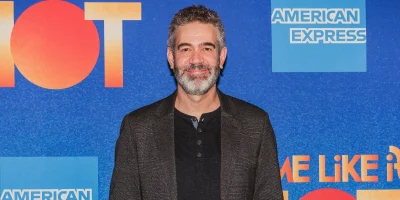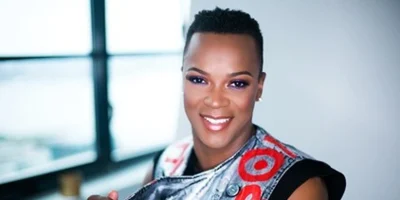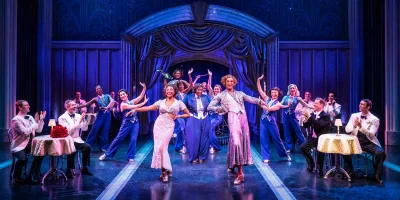
Costume designer Gregg Barnes on fashioning the 1930s in 'Some Like It Hot'
Costume designer Gregg Barnes talks about the extensive process of sourcing vintage costume pieces for the Broadway musical, which received 13 Tony nominations.
Designing costume pieces for a big, brassy musical with a 26-person ensemble is a tall order. Sourcing vintage pieces for a 1930s show spanning multiple seasons and locations, from winter in Chicago to summer in Tijuana, is another level of challenge. Costume designer Gregg Barnes was up to the task with Some Like It Hot, and his colorful, authentic design garnered a 2023 Tony nomination — one of the musical’s 13 nods, the most of any show this season. His work on the musical already won him the Outer Critics Circle Award for Outstanding Costume Design.
“Doing what I do, people see the frosting, but really, you have to bake the cake first,” said Barnes. “How do we get from A to B? And how do we fit it into the budget? How do we serve the story?”
The Some Like It Hot musical, based on the same-named 1959 film, starts in Prohibition-era Chicago and follows two jazz musicians, Joe (Christian Borle) and Jerry (J. Harrison Ghee). When the duo witnesses a mob crime, they flee in disguise as part of an all-female swing band called Sweet Sue and Her Society Syncopators.

The musical takes audiences on a journey from a Chicago nightclub on a cross-country train ride to San Diego, and there are a lot of frills, furs, and fedoras on the way. The costume design process “was complicated, but in a good way, by the fact that we wanted to put as much vintage [on stage] so that the heart of it was actually rooted in real things people would associate as being from the ‘30s,” said Barnes.
The 1930s decade, “in many ways, is the standard of elegance,” said Barnes. But sourcing authentic period clothing is labor-intensive and involves lots of research. For his part, Barnes grappled with several questions about the integrity and value of vintage wear. “Is it going to hold up? Is anybody even going to care?” recalled Barnes.
The hardest part of the research process was finding inspiration for everyday wear for the African American characters. “There's a lot [of photos] in the ‘20s, there's a lot in the ‘40s,” said Barnes. “But in the ‘30s, except for the Harlem Renaissance… I had a terrible time finding just folks on the train. It speaks to the time — it speaks to many things.” As such, costumes inspired by the Harlem Renaissance research take center stage with glittering, bias-cut dresses and cloche hats.
The end result of all his research was worth the effort. “It’s a lot of paperwork to keep it in order, but I have an amazing team!” Barnes said.

Some Like It Hot marks Barnes’s ninth Tony nomination — he won for The Drowsy Chaperone and Follies — but it isn’t old hat. “I’m always surprised,” said Barnes of his nominations. He’s heartened to see that a younger generation is coming up in the theatre design community, but that there’s still space where the “older generation can still flourish.”
Throughout Barnes’s decades-long career, he’s learned that the collaborative efforts of an enthusiastic cast and crew are more important than accolades. The silver bullet, though, is when the two collide, like in Some Like It Hot.
“It's the team — that is what's important because if it's something that really has your heart, but it's with the wrong family, it's a double letdown,” said Barnes. “When it's with the right people, it can be a joy ride for the entire journey.”
Frequently asked questions
What is Some Like It Hot on Broadway about?
The jazzy, brassy Billy Wilder film starring Marilyn Monroe is now a musical comedy. Travel cross-country with Joe and Jerry, two musicians who go undercover with an all-female swing band and try to find love along the way. Learn more about tickets to this energetic Broadway spectacle with music from Marc Shaiman and Scott Wittman (Hairspray).
Where is Some Like It Hot on Broadway playing?
Some Like It Hot on Broadway is playing at Shubert Theatre. The theatre is located at 225 West 44th Street (between Broadway and 8th Avenue), New York, 10036.
How long is Some Like It Hot on Broadway?
The running time of Some Like It Hot on Broadway is 2h 30m (incl. intermission)
What's the age requirement for Some Like It Hot on Broadway?
The recommended age for Some Like It Hot on Broadway is Recommended for 12+. Children under the age of 4 are not permitted in the theatre..
How do you book tickets for Some Like It Hot on Broadway?
Book tickets for Some Like It Hot on Broadway on New York Theatre Guide.
Who wrote Some Like It Hot?
Some Like It Hot is written by Matthew Lopez and Amber Ruffin (book, adapted from Billy Wilder and I. A. L. Diamond's screenplay), and Marc Shaiman and Scott Wittman co-wrote the score. Both duos received Tony Award nominations for their work.
What songs are in Some Like It Hot?
Some Like It Hot features a fully original score by Marc Shaiman and Scott Wittman, with '30s-jazz-inspired songs like "Let's Be Bad," "You Coulda Knocked Me Over With a Feather," and the title track. Learn more about all the songs in Some Like It Hot on Broadway.
Is the Some Like It Hot musical the same as the movie?
Some Like It Hot is closely based on the same-named 1959 film by Billy Wilder. The musical contains more songs and changes some characterizations.
Is Some Like It Hot appropriate for kids?
Some Like It Hot is recommended for ages 12 and older due to some strong language, brief depictions of violence, and mild sexual references. Please note that children 4 and younger are not permitted in Broadway theatres.
Who directed and choreographed Some Like It Hot?
Casey Nicholaw directed and choreographed Some Like It Hot, winning a Tony Award for the latter. He's also staged mega-musicals like Aladdin, The Book of Mormon, and The Prom.
Is Some Like It Hot good?
Some Like It Hot received more Tony Award nominations than any other show in 2023 and is among the best-reviewed shows on New York Theatre Guide. Our four-star review calls the show "a bracing, fizzy cocktail garnished with a winning cast."
Originally published on






